
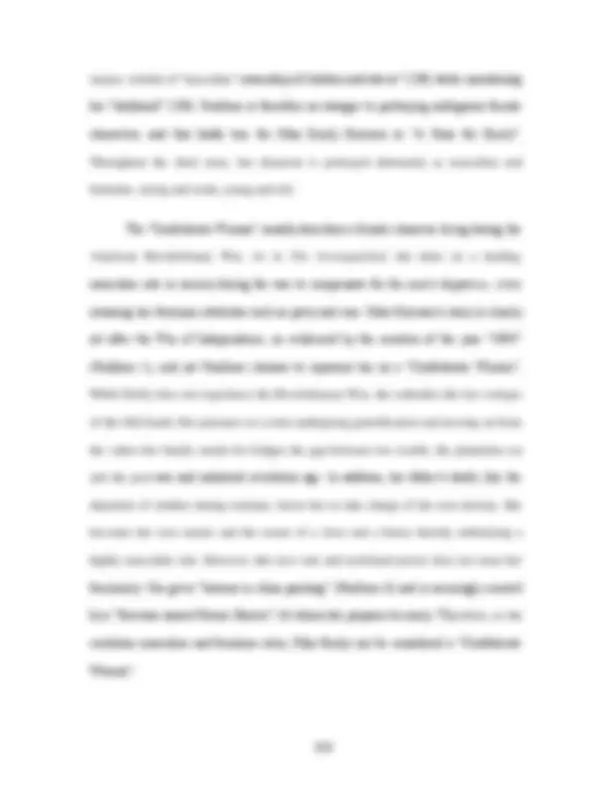
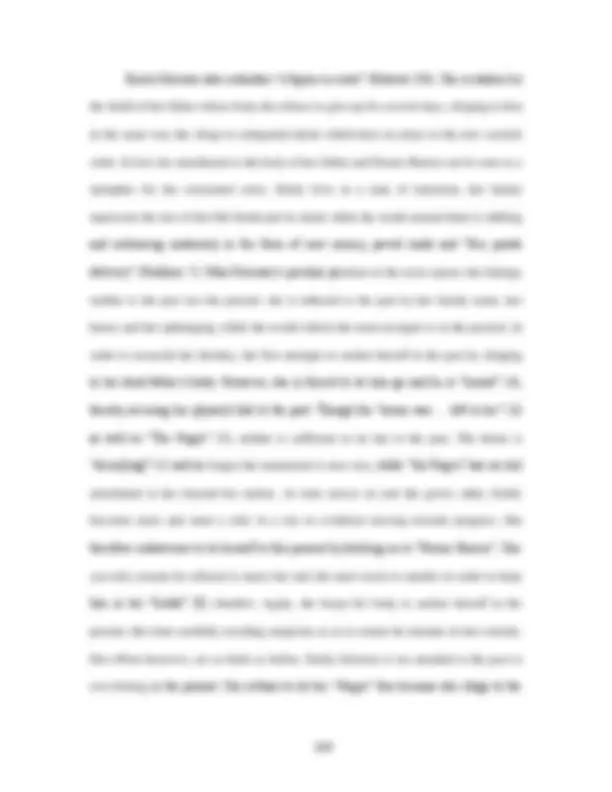
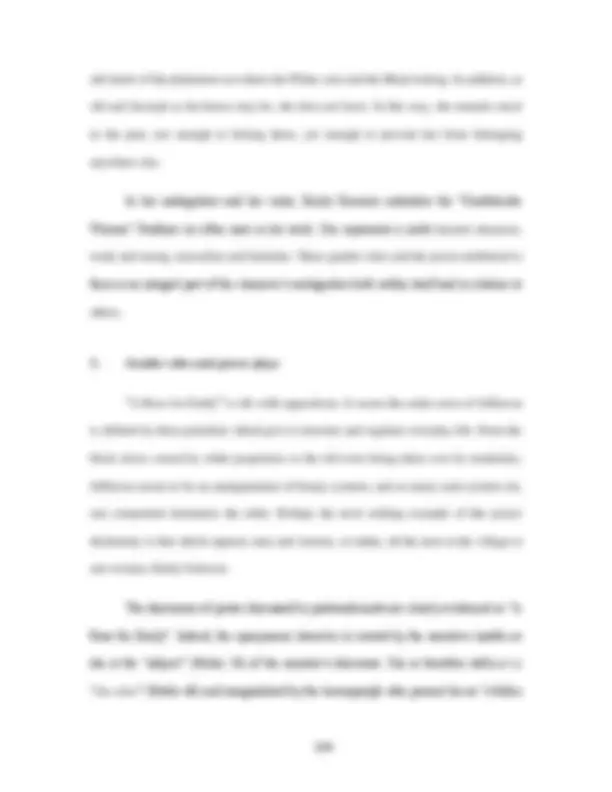
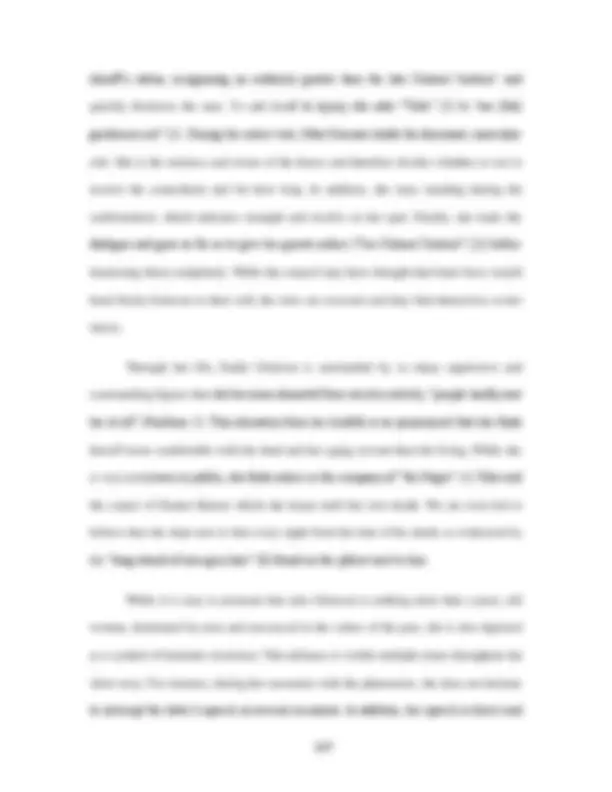
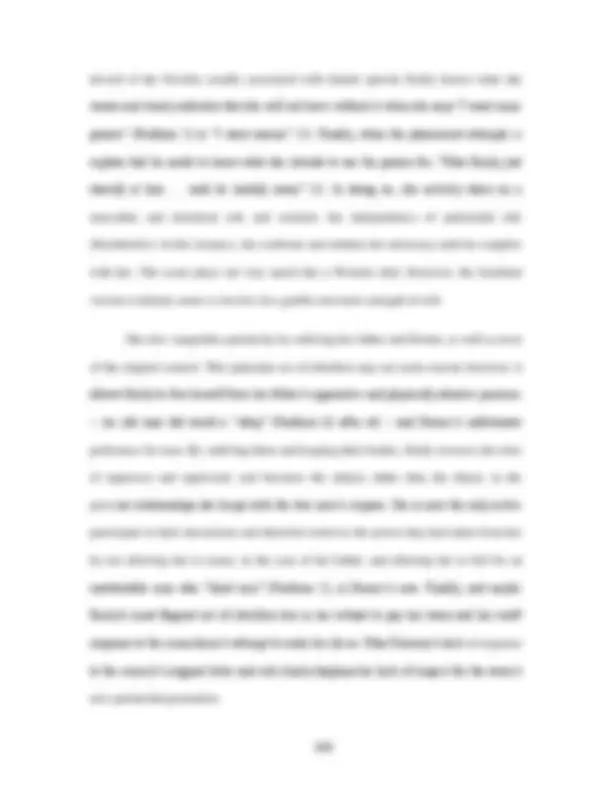
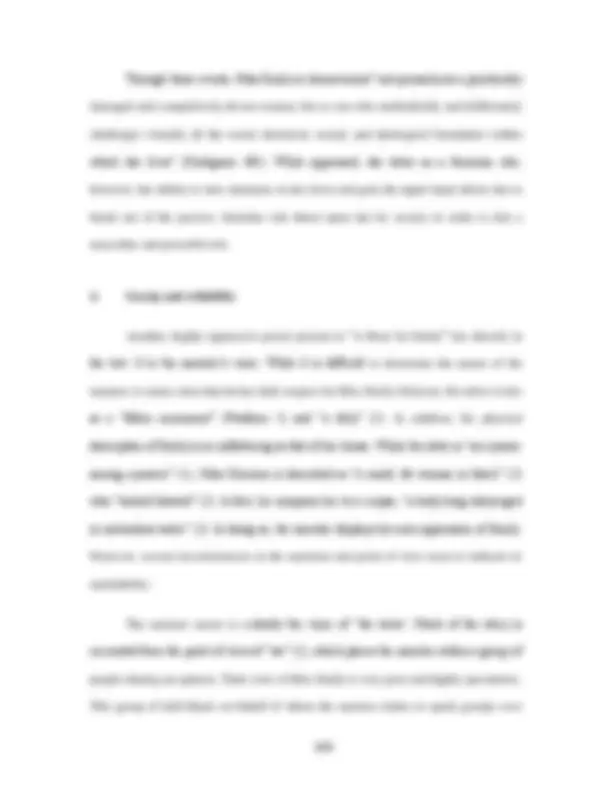
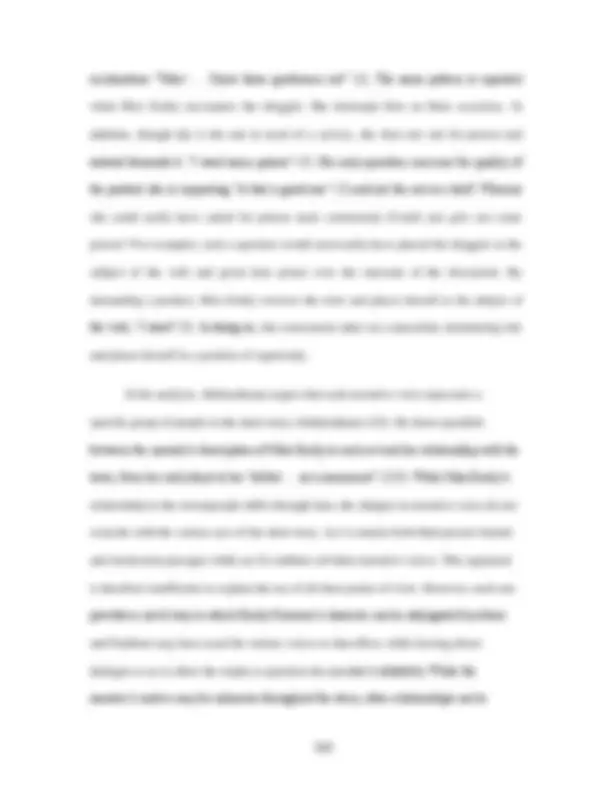
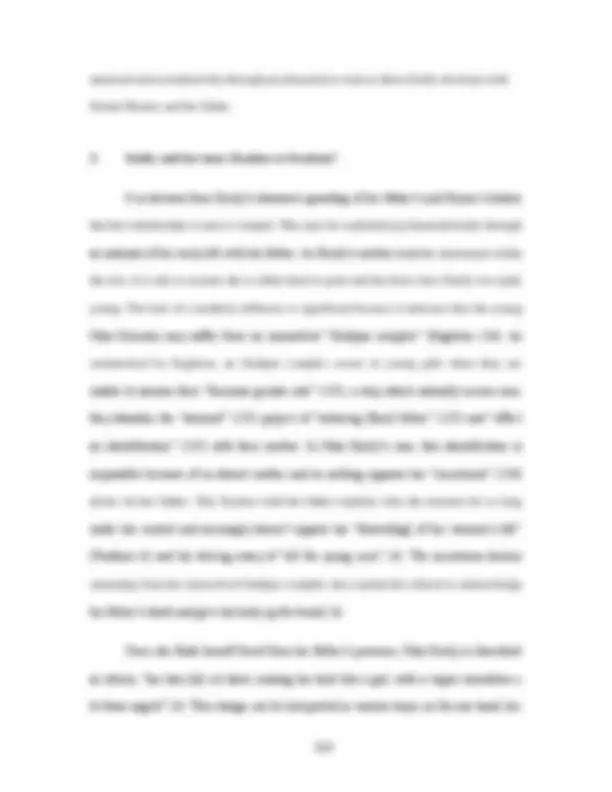
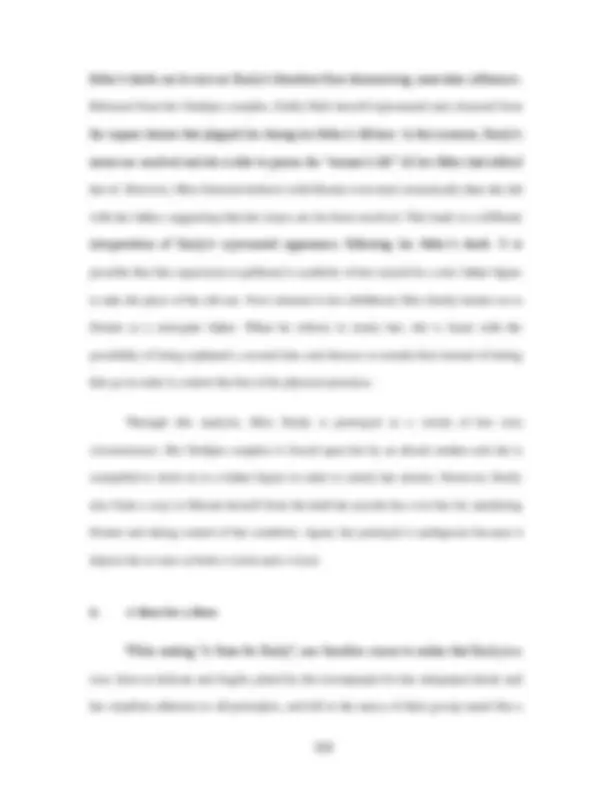


Study with the several resources on Docsity

Earn points by helping other students or get them with a premium plan


Prepare for your exams
Study with the several resources on Docsity

Earn points to download
Earn points by helping other students or get them with a premium plan
Community
Ask the community for help and clear up your study doubts
Discover the best universities in your country according to Docsity users
Free resources
Download our free guides on studying techniques, anxiety management strategies, and thesis advice from Docsity tutors
Through a close reading of the text, a postmodern, feminist and. Page 2. 101 psychoanalytic analysis of the text and its characters, we will see that the rose, ...
Typology: Lecture notes
1 / 17

This page cannot be seen from the preview
Don't miss anything!










By Justine Schweizer Abstract As one of the most prominent figures of Southern literature, William Faulkner is known for his highly accurate and critical depictions of the South, most notably during itstransition from the plantation era to the industrial age. His work presents all aspects of the changing South and its colourful cast of characters. Perhaps none are as emblematic and ambiguous as that of ―A Rose for Emily‖‘s eponymous character, Emily Grierson. Through his innovative use of narration and his portrayal of her, Faulkner represents the transitioning South as it moves from one era to the next, with all the crises andcomplexities it entails. Written in the prime of the feminist movement, ―A Rose for Emily‖ portrays a character caught between identities: the masculine and the feminine, the past and the present, the passive and the active. Going from subject to object and back again throughout the narrative, Miss Emily Grierson is the embodiment of the rose her creator symbolically gifts her. She is the petals of the flower, supple and soft, and thethorns of the stem, harsh and unyielding.
1. Introduction
―A Rose for Emily‖ is one of William Faulkner‘s most studied works. Written in 1930, the short story follows the downfall of Miss Emily Grierson, from her early womanhood to her eventual death. Like much of Faulkner‘s work, the action takes place in the fictional town of Jefferson, Mississippi during the late 1800s and early 1900s. Faulkner was clearly fascinated with the old American South and its slow decay following the Revolutionary War, to be replaced by an unfamiliar ―New South‖ (Roberts 234). While this theme, and many other recurring aspects of Faulkner‘s writing, such as the importance and use of time, can be found in ―A Rose for Emily‖, a more sparingly studied facet of the short story lies in the title and its relation to the eponymous character. Why does Faulkner ‗give‘ a rose to Emily? And why does he associate her to that particular flower? Through a close reading of the text, a postmodern, feminist and
psychoanalytic analysis of the text and its characters, we will see that the rose, with its soft petals and sharp thorns, is in fact emblematic of Emily and defines her character throughout the story.
2. William Faulkner and the Confederate Woman: a tale of ambiguity
William Faulkner (1897-1962) was born and lived most of his life in Mississippi. His life was therefore embedded in the South and he was greatly influenced by his heritage and everything it entailed. While the Revolutionary War (1775-1783) was long over by the time he was born, Faulkner was fascinated by the changes that occurred in the South between the period preceding it and the evolution in ideology and society that followed it. This is illustrated in much of his work, most of which is set in the fictional county of Yoknapatawpha. As in ―A Rose for Emily‖, Faulkner‘s work often portrays the changing of the guard between the highly hierarchical society of the old South, based on property and status, race and slavery, and the society of the ―New South‖ (Roberts 234), which was formed during and after the industrial revolution, and left behind ideas of aristocracy for gentrification. One hallmark of this transition is the character which has been defined as ―the Confederate Woman‖ (233). She is an essential element in many of Faulkner‘s stories as he reimagined her to embody ―a figure in crisis‖ (234) and represent the ―wreck of a society through fluid gender and race roles‖ (234). As Roberts defines her, ―[t]he Confederate Woman comes from women taking on traditionally masculine roles but with no sacrifice of what the culture identifies as essential white femininity‖ (235). Faulkner uses the ―Confederate Woman‖ (233) in stories such as The Sound and the Fury , Absalom, Absalom and The Unvanquished. In the latter, Rosa Millard ―becomes
Emily Grierson also embodies ―a figure in crisis‖ (Roberts 234). She is shaken by the death of her father whose body she refuses to give up for several days, clinging to him in the same way she clings to antiquated ideals which have no place in the new societal order. In fact, her attachment to the body of her father and Homer Barron can be seen as a metaphor for her existential crisis. Emily lives in a time of transition, her family represents the last of the Old South and its ideals while the world around them is shifting and embracing modernity in the form of new money, paved roads and ―free postal delivery‖ (Faulkner 7). Miss Grierson‘s peculiar position in the town means she belongs neither to the past nor the present: she is tethered to the past by her family name, her house and her upbringing, while the world which she must navigate is in the present. In order to reconcile her identity, she first attempts to anchor herself in the past by clinging to her dead father‘s body. However, she is forced to let him go and he is ―buried‖ (4), thereby severing her physical link to the past. Though the ―house was … left to her‖ (3) as well as ―The Negro‖ (5), neither is sufficient to tie her to the past. The house is ―decay[ing]‖ (1) and no longer the monument it once was, while ―the Negro‖ has no real attachment to her beyond his station. As time moves on and she grows older, Emily becomes more and more a relic in a city in evolution moving towards progress. She therefore endeavours to tie herself to this present by latching on to ―Homer Barron‖. One can only assume he refused to marry her and she must resort to murder in order to keep him in her ―bridal‖ (8) chamber. Again, she keeps his body to anchor herself in the present, this time carefully avoiding suspicion so as to ensure he remains in her custody. Her efforts however, are as futile as before. Emily Grierson is too attached to the past to ever belong in the present. She refuses to let her ―Negro‖ free because she clings to the
old ideals of the plantation era where the White own and the Black belong. In addition, as old and decrepit as her house may be, she does not leave. In this way, she remains stuck in the past, not enough to belong there, yet enough to prevent her from belonging anywhere else.
In her ambiguities and her crisis, Emily Grierson embodies the ―Confederate Woman‖ Faulkner so often uses in his work. She represents a multi-faceted character, weak and strong, masculine and feminine. These gender roles and the power attributed to them is an integral part of the character‘s ambiguities both within itself and in relation to others.
3. Gender roles and power plays
―A Rose for Emily‖ is rife with oppositions. It seems the entire town of Jefferson is defined by these polarities which give it structure and regulate everyday life. From the black slaves owned by white proprietors to the old town being taken over by modernity, Jefferson seems to be an amalgamation of binary systems, and as many such systems do, one component dominates the other. Perhaps the most striking example of this power dichotomy is that which opposes men and women, or rather, all the men in the village to one woman, Emily Grierson.
The discourses of power discussed by postmodernists are clearly evidenced in ―A Rose for Emily‖. Indeed, the eponymous character is created by the narrative insofar as she is the ―subject‖ (Butler 56) of the narrator‘s discourse. She is therefore defined as ― the other ‖ (Butler 46) and marginalized by the townspeople who present her as ―a fallen
was so strong that he forbade her from marrying. He ―thwart[s] her woman‘s life‖ (6) repeatedly and constantly oppresses Miss Grierson.
The patriarchy‘s oppression of Emily is also visible in her interactions with the city council. While the previous mayor – Colonel Sartoris – had dispensed her from paying taxes, the new generation in power disagrees with the edict and a delegation of councilmen is sent to Miss Grierson‘s house in order to persuade her to pay her dues to the town when letters remain unanswered. By showing up in numbers, the councilmen hope to intimidate and subdue Emily, something they had failed to do through their letters and calls. The evident lack of respect shown by the new generation of councilmen towards their predecessors, and by extension Emily, exposes their oppressive standpoint. Their relative position of power as members of the city council affords them fairly easy means of pressuring Emily into paying taxes, even though they must be aware of her dire financial situation.
However, Miss Emily ―vanquishe[s] them, horse and foot‖ (2) by referring them to the late Colonel Sartoris who she knows is dead. She stands firm in her resolve and recognizes the threat they pose on her identity. Their lack of respect for her position as a Lady is evidenced by their will to revoke her tax ―arrangement‖ (1) and she is quick to put them in their place. Emily does not receive the envoys of the council as a good hostess but rather like a war general. ―She d[oes] not ask them to sit‖ (2) and stays standing herself, indicating a clear confrontation between two parties. This refusal to sit demonstrates a masculine stance on Emily‘s part, as does the scene that follows. Emily is ―dry and cold‖ (2) and rattles her visitors so that they are left ―stumbling‖ (2). Her answers are short and clipped and leave no room for argument. She questions the
sheriff‘s status, recognizing no authority greater than the late Colonel Sartoris‘ and quickly dismisses the men. To add insult to injury, she asks ―Tobe‖ (2) to ―see [the] gentlemen out‖ (2). During the entire visit, Miss Grierson holds the dominant, masculine role. She is the mistress and owner of the house and therefore decides whether or not to receive the councilmen and for how long. In addition, she stays standing during the confrontation, which indicates strength and resolve on her part. Finally, she leads the dialogue and goes so far as to give her guests orders (―See Colonel Sartoris‖ (2)) before dismissing them completely. While the council may have thought that brute force would bend Emily Grierson to their will, the roles are reversed and they find themselves at her mercy.
Through her life, Emily Grierson is surrounded by so many oppressive and commanding figures that she becomes alienated from society entirely, ―people hardly saw her at all‖ (Faulkner 2). This alienation from her kinfolk is so pronounced that she finds herself more comfortable with the dead and her aging servant than the living. While she is very rarely seen in public, she finds solace in the company of ―the Negro‖ (1) Tobe and the corpse of Homer Barron which she keeps until her own death. We are even led to believe that she slept next to him every night from the time of his death, as evidenced by the ―long strand of iron-grey hair‖ (8) found on the pillow next to him.
While it is easy to presume that miss Grierson is nothing more than a poor, old woman, dominated by men and ensconced in the values of the past, she is also depicted as a symbol of feminine resistance. This defiance is visible multiple times throughout the short story. For instance, during her encounter with the pharmacist, she does not hesitate to interrupt the latter‘s speech on several occasions. In addition, her speech is direct and
Through these events, Miss Emily is characterized ―not primarily as a psychically damaged and compulsively driven woman, but as one who methodically and deliberately challenges virtually all the social, historical, sexual, and ideological boundaries within which she lives‖ (Kartiganer 481). While oppressed, she takes on a feminine role; however, her ability to turn situations in her favor and gain the upper hand allows her to break out of the passive, feminine role thrust upon her by society in order to don a masculine and powerful role.
4. Gossip and reliability
Another, highly oppressive power present in ―A Rose for Emily‖ lies directly in the text. It is the narrator‘s voice. While it is difficult to determine the nature of the narrator, it seems clear that he has little respect for Miss Emily Grierson. He refers to her as a ―fallen monument‖ (Faulkner 1) and ―a duty‖ (1). In addition, his physical description of Emily is as unflattering as that of her house. While the latter is ―an eyesore among eyesores‖ (1), Miss Grierson is described as ―a small, fat woman in black‖ (2) who ―looked bloated‖ (2). In fact, he compares her to a corpse, ―a body long submerged in motionless water‖ (2). In doing so, the narrator displays his own oppression of Emily. However, several inconsistencies in the narration and point of view seem to indicate its unreliability.
The narrator seems to embody the voice of ‗the town‘. Much of the story is recounted from the point of view of ―we‖ (1), which places the narrator within a group of people sharing an opinion. Their view of Miss Emily is very poor and highly speculative. This group of individuals on behalf of whom the narrator claims to speak gossips over
any and every event involving Miss Grierson. Her purchase of arsenic is immediately followed by their expectation that ―She will kill herself‖ (5) while her frequent outings with Homer Barron led to the speculation that ―She w[ould] marry him‖ (5). When the latter disappeared, this unnamed posy was quick to pity Emily. Like a group of bored housewives, they ―watch developments‖ (6), analyse behaviour and pass judgement without any direct knowledge of Miss Emily. They show pity, disappointment and anticipation as they watch Emily‘s life unfold before their eyes. Their gaze gives them power over the object of their attention. Miss Emily‘s life is depicted like a movie in which she plays the title role. She becomes a prop in a greater production meant to entertain others.
On the other hand, some of the story is told from a third person omniscient point of view which clashes with the rest of the text. Such is the case for the passages depicting Miss Grierson‘s interview with the councilmen and her visit to the ―druggist‖ (5). This change in narration is useful to the text as it provides the reader with knowledge he may not acquire otherwise, however, this supposes that the men present in both instances (the councilmen and the druggist) are not part of the greater ―we‖ (1) usually employed by the narrator. This seems to indicate that the general ―we‖ often used for narration does not include men, which is realistic considering the resemblance of that voice to ―gossip‖ (Klein 229). In fact, Klein argues that Faulkner was attempting in this way to recreate the voice of ―society columnists‖ (231). The change in narrative stance also serves a second purpose. It allows the reader to creep into the private life of Miss Emily Grierson more completely. This is yet another way in which the narrator oppresses her. His pervasive
exclamation ―Tobe! … Show these gentlemen out‖ (2). The same pattern is repeated when Miss Emily encounters the druggist. She interrupts him on three occasions. In addition, though she is the one in need of a service, she does not ask for poison and instead demands it, ―I want some poison‖ (5). Her only question concerns the quality of the product she is requesting ―Is that a good one‖ (5) and not the service itself. Whereas she could easily have asked for poison more courteously (Could you give me some poison? For example), such a question would necessarily have placed the druggist as the subject of the verb and given him power over the outcome of the discussion. By demanding a product, Miss Emily reverses the roles and places herself as the subject of the verb, ―I want‖ (5). In doing so, she consciously takes on a masculine, dominating role and places herself in a position of superiority.
In his analysis, Abdurrahman argues that each narrative voice represents a specific group of people in the short story (Abdurrahman 225). He draws parallels between the narrator‘s description of Miss Emily in each act and her relationship with the town, from her early days to her ―defeat … as a monument‖ (225). While Miss Emily‘s relationship to the townspeople shifts through time, the changes in narrative voice do not coincide with the various acts of the short story. Act I contains both third person limited and omniscient passages while act II combines all three narrative voices. This argument is therefore insufficient to explain the use of all these points of view. However, each one provides a novel way in which Emily Grierson‘s character can be subjugated by others and Faulkner may have used the various voices to that effect, while leaving direct dialogue so as to allow the reader to question the narrator‘s reliability. While the narrator‘s motive may be unknown throughout the story, other relationships can be
analysed more productively through psychoanalysis such as those Emily develops with Homer Barron and her father.
5. Emily and her men: fixation or freedom?
It is obvious from Emily‘s obsessive guarding of her father‘s and Homer‘s bodies that her relationship to men is warped. This may be explained psychoanalytically through an analysis of her early life with her father. As Emily‘s mother is never mentioned within the text, it is safe to assume she is either dead or gone and has been since Emily was quite young. The lack of a motherly influence is significant because it indicates that the young Miss Grierson may suffer from an unresolved ―Oedipus complex‖ (Eagleton 134). As summarized by Eagleton, an Oedipus complex occurs in young girls when they are unable to assume their ―feminine gender role‖ (135), a step which naturally occurs once they abandon the ―doomed‖ (135) project of ―seducing [their] father‖ (135) and ―effect an identification‖ (135) with their mother. In Miss Emily‘s case, this identification is impossible because of an absent mother and so nothing opposes her ―incestuous‖ (134) desire for her father. This fixation with her father explains why she remains for so long under his control and seemingly doesn‘t oppose his ―thwart[ing] of her woman‘s life‖ (Faulkner 6) and his driving away of ―all the young men‖ (4). The incestuous desires stemming from her unresolved Oedipus complex also explain her refusal to acknowledge her father‘s death and give his body up for burial (4).
Once she finds herself freed from her father‘s presence, Miss Emily is described as reborn, ―her hair [is] cut short, making her look like a girl, with a vague resemblance to those angels‖ (4). This change can be interpreted in various ways; on the one hand, her
rose to the weather, she is nonetheless a symbol of resistance. Emily resists the patriarchy‘s attack on her by refusing to pay her taxes and standing up to male figures. She also resists time by outliving her main oppressor, her father. Emily has her thorns and she uses them to stand up to the town‘s patriarchal society, while never losing her composure and keeping the grace of the rose the author gifted her.
While others have likened the rose to ―secrecy: the confidential relationship between the author and his character‖ (Getty 232) or as implying ―that Miss Emily deserves a rose for having attempted … to triumph over time and place in her quest for love.‖ (Going), these analyses do not coincide with the recurring rose seen in the story. Getty‘s exploration fails to account for the comparison seen throughout the story, likening Emily herself to a rose, such as in the subtle description of what became Homer Barron‘s death chamber: ―upon the valance curtains of faded rose color, upon the rose shaded lights‖ (Faulkner 8). As for Going, his explanation is invalid insofar as Emily never did triumph ―in her quest for love‖ (Going).
7. Conclusion
It is probably fair to assume that Faulkner was keenly aware of his depiction of gender struggles as he wrote ―A Rose for Emily‖. The short story was written in 1930, just as the first wave of feminist movements rocked through the United States and right after the right of vote was granted in the country. It is therefore likely that each element, including his choice of title and specific flower, were thought out in this very context of rising feminism. The symbolic nature of the rose as an instrument of love should not be overlooked. It may represent Faulkner‘s attempt to finally reconcile Emily with the love
she was never given during her life. However, its well-known dichotomy of petals and thorns seems more likely to represent Emily herself than a fictional love. Her constant search for her own identity in a changing world unconcerned with her happiness leads her to take on conflicting roles in society, she is in turn placed on a pedestal and denigrated by her neighbours, powerful and powerless, much like a rose can be soft and pliant or sharp and prickly in turn.
Works Cited
Abdurrahman, Israa‘ Burhanuddin. ―A Stylistic Analysis of Complexity in William Faulkner‘s ‗A Rose for Emily.‘‖ Advances in Language and Literary Studies , vol. 7, no. 4, 2016, pp. 220–30, doi:10.7575/aiac.alls.v.7n.4p.220. Butler, Christopher. ―Politics and Identity.‖ Post-Modernism: A Very Short Introduction , Oxford University Press, 2002, pp. 44–61. de Beauvoir, Simone. The Second Sex. First Vint, Random House, Inc., 2010. Eagleton, Terry. ―Psychoanalysis.‖ Literary Theory: An Introduction , 2nd^ ed., Blackwell Publishing, 1996, pp. 131–68, doi:10.1080/13698019800510071. Faulkner, William. ―A Rose for Emily.‖ The Forum , 6th ed., 1930. Getty, Laura J. ―Faulkner‘s ‗A Rose for Emily.‘‖ The Explicator , vol. 63, no. 4, 2005, pp. 230 – 34. Going, William T. ―Faulkner, A Rose for Emily.‖ The Explicator , vol. 16, 1957, p. 27. Kartiganer, Donald M. ―Tobe! Show These Gentlemen Out.‖ The Mississippi Quarterly , vol. 64, no. 3–4, 2011, pp. 480–82. Kirchdorfer, Ulf. Explicator , vol. 75, no. 3, 2017, pp. 145 ―Weak Men in William Faulkner‘s A ROSE FOR EMILY.‖–47, doi:10.1080/00144940.2017.1346564. The
Klein, Thomas. ―The Ghostly Voice of Gossip in Faulkner‘s A ROSE FOR EMILY.‖ The Explicator , vol. 65, no. 4, 2007, pp. 229–32, doi:10.3200/EXPL.65.4.229-232. Roberts, Diane. ―A Precarious Pedestal: The Confederate Woman in Faulkner‘s Unvanquished. ‖ Journal of American Studies , vol. 26, no. 2, 1992, pp. 233–46, doi:10.1017/S0021875800030772.